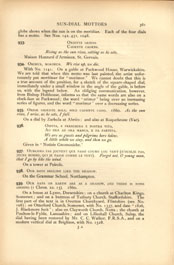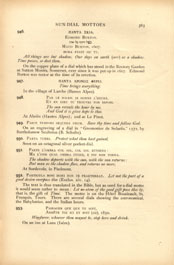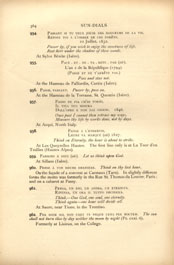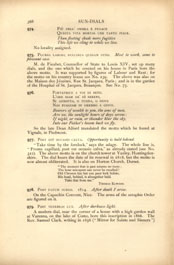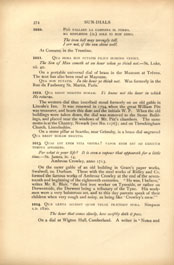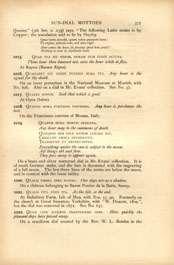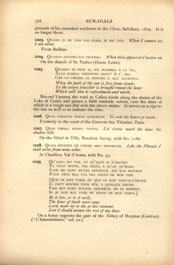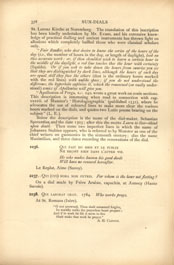Sun-Dial Mottoes (continued.)
globe shows when the sun is on the meridian. Each of the four dials has a motto. See Nos. 142, 431, 1048. |
|
| 933. |
ORIENTE ORIENS Maison Henrard d'Armieux, St. Gervais. |
| 934. | ORIMUR, MORIMUR. We rise up, we die. With No. 1141. On a gable at Packwood House, Warwickshire. We are told that when this motto was last painted, the artist unfortunately put mortimur for "morimur." We cannot doubt that this is a true account of the position, for a sketch of the square-shaped dial, immediately under a small window in the angle of the gable, is before us, with the legend below. An obliging communication, however, from Bishop Hobhouse, informs us that the same words are also on a clock-face at Packwood; the word "orimur" being over an increasing series of figures, and the word "morimur" over a decreasing series. |
| 935. | ORIOR ORIENTE SOLE, SOLE CADENTE CADO. 1860. As the sun rises, I arise, as he sets, I fall. On a dial by Zarbula at Abriès ; and also at Roquebrune (Var). |
| 936. |
Given in "Notizie Gnomoniche." |
| 937. | OUBLIDES PAS JOUVENT QUE PASSI COUMO LOU VENT (N'OUBLIE PAS, JEUNE HOMME, QUI JE PASSE COMME LE VENT). Forget not, O young man, that I go by like the wind. On a tower at Peirole. |
| 938. | OUR DAYS DECLINE LIKE THE SHADOW. On a Grammer School, Northampton. |
| 939. | OUR DAYS ON EARTH ARE AS A SHADOW, AND THERE IS NONE ABIDING (I Chron. xx. 15). 1860. On a house at Lyme, Dorsetshire; on a church at Charlton Kings, Somerset; and on a buttress of Tutbury Church, Staffordshire. The first part of the text is in Overton Churchyard, Flintshire (see No. 108); on Otterford Church, Somerset, with No. 1337, and the date "1826, J. Blackmore fecit"; also on Clayworth Church, Notts; the church at Poulton-le-Fylde, Lancashire; and on Lilleshall Church, Salop, the dial having been restored by Mr. C. C. Walker, F.R.S.A., and on a modern vertical dial at Brighton, with No. 1528. |
| 940. | OUR DAYS ON EARTH ARE AS A SHADOW, In the gardens fronting the house at Gale Syke, Wastwater, is a horizontal dial thus inscribed. It was erected about 1852-3, and presented to the then owner of the place, Stansfield Rawson, Esq., by one of his daughters. It was said to have been designed by Mr. Rawson's son-in-law, the Rev. Dr. Worsley, late master of Downing College, Cambridge. |
| 941. | OUR DAYS PASS LIKE A SHADOW. On the old church at Whitby, Yorkshire, cut in stone and dated 1757. |
| 942. | OUR LIFE'S A FLYING SHADOW, GOD'S THE POLE: Formerly on Milton Church, Berks; and on Ebberston Church, near Scarborough, with No. 732, and "F. Thorpe delineavit 1843"; The same motto, with Nos. 289, 1490, was on Glasgow Cathedral, but has now disappeared. Leadbetter (1756) mentions this as "on the High Church wall." |
| 943. | OUR TIME'S AT HAND. On the church porch, Minster, Sheppey. |
| 944. |
A writer in the "Gentleman's Magazine," February, 1792, p. 121, said: "I found yesterday, in the 'Anthologia, ' a curious philosophical bagatelle, an inscription for a dial containing twelve words, and, as it seems, intentionally limited to that number. It is well known to your Grecian readers that λιθος in the feminine, denotes a gem. This was probably therefore a very small dial." The Latin and English versions of the inscription were also given in the "Gentleman's Magazine." Both they and the Greek lines have been exactly copied. We are not responsible for the spelling. Probably ΑΕΛϒΩ should be ΑΕΛΙΟϒ. |
| 945. | ΠΑΝΤΑ 'ΑΝΑΦΕΡΕΙ ΧΡΟΝΟΣ. Time brings all things back. On an octahedral dial in Mr. L. Evans' collection, see No. 295. |
| 946. |
ΠΑΝΤΑ ΣΚΙΑ. All things are but shadow, Our days on earth (are) as a shadow. Time passes, so dost thou. On a copper plate of a dial which has stood in the Rectory Garden at Sutton Montis, Somerset, ever since it was put up in 1607. Edmond Burton was rector at the time of its erection. |
| 947. |
ΠΑΝΤΑ
ΧΡΟΝΟΣ
ΦΕΡΕΙ
In the village of Larche (Basses Alpes). |
| 948. | PAR LE SOLEIL JE DONNE L'HEURE, At Abriès (Hautes Alpes); and at Le Pinet. |
| 949. | PARCE TEMPORI SEQUERE DEUM. Save thy time and follow God. On an engraving of a dial in "Gnomonice de Solariis," 1572, by Bartholomew Scultetus (B. Schultz). |
| 950. | PARTA TUERI. Protect what thou hast gained. Seen on an octagonal silver pocket-dial. |
| 951. | PARTE L'OMBRA COL SOL, COL SOL RITORNA: At Sordevole, in Piedmont. |
| 952. | PARTICULA BONI DONI NON TE PREAETEREAT. Let not the part of a good desire overpass thee (Ecclus. xiv. 14). The text is thus translated in the Bible, but as used for a dial motto it would seem rather to mean: Let no atom of the good gift pass thee by, that is, the gift of Time. The motto is on the Hôtel Boucicault, St. François, Tours. There are several dials showing the astronomical, the Babylonian, and the Italian hours. |
| 953. | PASSAGER QUE QUE TU SOIT, Wayfarer, whoever thou mayest be, stop here and drink. On an inn at Lans (Isère). |
| 954. |
PASSANT SI TU VEUX JOUIR DES DOUCEURS DE LA VIE,
Passer by, if you wish to enjoy the sweetness of life,
At Sylve Bénite (Isère). |
| 955. |
PACE . ET . NE . TA . RETE . PAR (sic).
At the Hameau de Palliardin, Curtin (Isère). |
| 956. | PASSE, PASSANT. Passer by, pass on. At the Hameau de la Terrasse, St. Quentin (Isère). |
| 957. |
At Acqui, North Italy. |
| 958. |
At Les Queyrelles Hautes. The first line only is at La Tour d'en Trolliet (Hautes Alpes). |
| 959. | PANSONS À DIEU (sic). Let us think upon God. At Sillans (Isère). |
| 960. | PENSE À TON HEURE DERNIÈRE. Think on thy last hour. On the façade of a convent at Carmaux (Tarn). In slightly different forms the motto was formerly in the Rue St. Thomas du Louvre, Paris; and on a cabaret at Passy. |
| 961. | PENSA, UN DIO, UN ANIMA, UN ETERNITÀ. At. Saure, near Tione, in the Trentino. |
| 962. | PER DIEM SOL NON URET TE NEQUE LUNA PER NOCTEM. The sun shall not burn thee by day neither the moon by night (Ps. cxxi. 6). Formerly at Lisieux, on the College. |
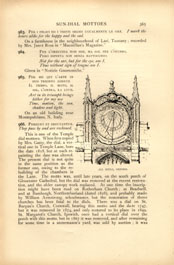
[Full Image]
ALL SOULS, OXFORD.
| 963. | PER I FELICI ED I TRISTI SEGNO UGUALMENTE LE ORE. I mark the hours alike for the happy and the sad. On a farmhouse in the neighbourhood of Lari, Tuscany; recorded by Mrs. Janet Ross in "Macmillan's Magazine." |
| 964. | PER L' ORECCHIA NON SON, MA SOL PER L'OCCHIO, Given in "Notizie Gnomoniche." |
| 965. | PER ME QUI L'ARTE IN SUO TRIONFO ADDUCE On an old building near Montepulciano, N. Italy. |
| 966. | PEREUNT ET IMPUTANTUR. They pass by and are reckoned. This is one of the Temple dial mottoes. When first copied by Mrs. Gatty, the dial, a vertical one in Temple Lane, bore the date 1818, but at each repainting the date was altered. The present dial is not quite in the same position as the former one, owing to the rebuilding of the chambers in the Lane. The motto was, until late years, on the south porch of Gloucester Cathedral, but the dial was removed at the recent restoration, and the older canopy work replaced. At one time the inscription might have been read on Rotherham Church; at Beadnell, and at Bamburgh, Northumberland (dated 1828), and probably made by William Armstrong, schoolmaster, but the restoration of these churches has been fatal to the dials. There was a dial on St. Buryan's Church, Cornwall, bearing this motto and the date 1747, but it was removed in 1874, and only restored to its place in 1899. St. Margaret's Church, Ipswich, once had a vertical dial over the porch with this motto, but in 1867 it was removed, and after remaining porch with this motto, but in 1867 it was removed, and after remaining for some time in a stonemason's yard, was sold by auction; it was |
in 1889 in a meat salemans's yard at Ipswich, and had been repainted and gilt. The fine dial placed by Sir Christopher Wren on the college of which he was a fellow, All Souls, Oxford, bears this motto. The dial was formerly on the chapel, but was some years ago moved to the wall of the library, where it is placed above one of the windows on a south wall. The motto may further be read at Hargrave Rectory, Northants; at Lympne, Kent; and on Lincoln Cathedral with No. 128; on the old Moot Hall at Aldeburgh, with No. 443; on Kildwick Church in Craven, Yorkshire; and Great Barton Church porch, Suffolk; in the churchyards of Garstang, Lancashire, with date 1757; of Aldington, Kent, dated 1799; on a wooden shaft at Brympton, near Yeovil, with No. 1499; in the rectory garden at Micheldean, with No. 354; and in the vicarage garden at Bishop Stortford, Herts; on the cross-dial at Elleslie, Chichester (see No. 104); and at Lavendon Grange, near Olney, dated 1626, over the principal entrance. Sir Isaac Newton was a frequent visitor at Lavendon, and no doubt often consulted this time-teller. It is also on a curious clock at Exeter Cathedral. The same motto is found on several continental dials, as on the Municipio at Palermo; and on the church of San Crocifisso, Pieve di Cadore (see Nos. 442, 1504, 1548); on that of Mens (Isère); at Mont Valezan sur Bellentre, Savoy; at Nus, Val d'Aosta; in the garden of the hospital of St. Jacques, Besançon (see No. 75); and formerly was on the college at Lisieux. The words of the motto are taken from an epigram by Martial, v. 20, II, the four last lines of which are as follows: "Nunc vivit sibi neuter, heu! bonosque Cowley translates these: Now to himself, alas! does neither live The sentiment is remarkable from a heathen writer, and somewhat more Christian, though often not more true, than that given to a lady who was being lionized at Oxford, and asked the meaning of the words: "They perish," said her waggish companion, "and are not thought of." PEREUNT ET IMPUTANTUR is also in the garden of Bremhill Rectory, Wilts, on a dial which stands on a twisted column in the midst of flower beds. It was put up by the Rev. W. L. Bowles, who also inscribed the following lines upon a hermitage, now destroyed, which stood near it: "To make like's few but fleeting hours, |
Which one by one came forth and died |
|
| 967. | PERGE SECURUS, MONSTRO VIAM. Proceed trustfully, I show the way. On an ivory portarium, now in the possession of Charles T. Gatty. The motto refers to the compass which is included in the portarium. It was made by Hans Troschel, and was bought at Nuremberg. The motto is also on a portarium in the Musée Cluny, Paris (see No. 404 and comp. No. 748). |
| 968. | PERICLITAMUR OMNI HORA. We stand in jeopardy every hour. (I Cor. xv. 30). At Aime, Savoy; and on the wall of the old Capuchin convent at Savona. |
| 969. | PETITO QUOD JUSTUM. Seek what is just. In Jamaica there is an old Spanish sun-dial placed on the parapet of the platform, before the main entrance to Great Pond House, parish of St. Anne, just in front of a pomegranate tree, which springs from the rock opposite the dial. The dial is inscribed as above. |
| 970. | PEUT-ÊTRE À L'HEURE QVE TV CONTE On a church at Ornon (Isère). |
| 971. | PEUT-ÊTRE LA DERNIÈRE. Perhaps the last. At the Maison Avignon, Mirepoix (Ariège). |
| 972. | PHOEBO ABSENTE NIL SUM. Without Phœbus I am nothing. At Gardes (Vaucluse). |
| 973. | PHOEBUS IN HOC SPERA (SPHERA) DAT NASCERE TEMPORIS HORIS. On this sphere Phœbus permits the hours of time to be born. On a dial at the Château de l'Isle d'Aval, near Dinan, the residence of M. Gaulter du Mottray. The dial is on a white marble slab and was brought from the Château du Vœu Meloisel, which belonged in the fifteenth and sixteenth centuries to the family of Desnos : on the upper part there is a shield quartered with the arms and mottoes of the families of Desnos and Matignon, and surrounded by the legend, "En tout par honneur." |
| 974. | PIÙ DELL' OMBRA È FUGACE No locality assigned. |
| 975. | PLURES LABORI, DULCIBUS QUIDAM OTIIS. Most to work, some to pleasant ease. M. de Fieubet, Counsellor of State to Louis XIV., set up many dials, and the one which he erected on his house in Paris bore the above motto. It was supported by figures of Labour and Rest; for the motto on his country house see No. 239. The above was also on the Maison des Jésuites, Rue St. Jacques, Paris; and is in the garden of the Hospital of St. Jacques, Besançon. See No. 75. |
| 976. | PORTATRICE A VOI DI BENE, So the late Dean Alford translated the motto which he found at Vignale, in Piedmont. |
| 977. | POST EST OCCASIO CALVA. Opportunity is bald behind. "Take time by the forelock." says the adage. The whole line is, "Fronte capillatâ, post est occasio calva," as already stated (see No. 322). The above motto is on the church tower at Yaxley, Huntingdonshire. The dial bears the date of its renewal in 1818, but the motto is now almost obliterated. It is also on Horton Church, Dorset. "The moment that is past returns no more; |
| 978. | POST FATUM SURGO. 1814. After death I arise. On the Capuchin Convent, Nice. The arms of the seraphic Order are figured on it. |
| 979. | POST TENEBRAS LUX. After darkness light. A modern dial, near the corner of a house with a high garden wall at Varenna, on the lake of Como, bore this inscription in 1866. The Rev. Samuel Clark, writing in 1656 ("Mirror for Saints and Sinners") |
observes that these words were written upon "a marble table in the town house of Geneva. Before Master Calvin opened their eyes by his ministry, their motto was Post tenebras spero lucem. Since they altered it to Post tenebras lux." |
|||||||
| 980. | POST TENEBRAS SPERO LUCEM. After darkness I hope for light. At Jordan Gate, Macclesfield (see No. 807). On a vertical dial in the courtyard of the Certosa, near Alatri; with others in the Passage du Petit St. Antoine, Paris (see No. 860); and at Ridley Hall (see No. 45). |
||||||
| 981. | POSUI DEUM ADJUTOREM MEUM. I have placed God as my helper. One of the mottoes on the dial pillar at Corpus Christi College, Oxford. |
||||||
| 982. | POURQUOI LA CHERCHER SI C'EST POUR LA PERDRE? 1828. Wherefore look for it if it is only to be lost? At Château Queyras (Hautes Alpes), with other mottoes. |
||||||
| 983. | POURQUOI SUR DE CADRAN SOLAIRE Why is not the usual shadow visible on this sun-dial?It is because in this place all our time is given to praising God. We desire to mark it in the highest way, and that is by borrowing a ray of light from Heaven. Inscribed on a dial within a Franciscan convent. The hour is shown by a ray of light. This kind of dial is called in France Cadran à la capucine, "La Cloche." |
||||||
| 984. | PRAECIPITES VALIDIS TARDAE LANGUENTIBUS HORAE. Swift are the hours to the healthy, slow to the sick. In a chemist's shop, Rue Bourg l'Abbé, Paris. |
||||||
| 985. | PRAESENS TIBI ULTIMA PLURIBUS. The present hour is life to thee, and death to many others. At Caussade (Tarn et Garonne). |
||||||
| 986. | PRÆSTANT ÆTERNA CADUCIS. The things eternal excel the transient. Noted in North Italy. |
||||||
| 987. |
There are two sun-dials at Farnham Castle, on the walls of the |
entrance tower. They had formerly the inscription, "Eheu fugaces, labuntur anni," but have now the more befitting words, "Prætereunt" on the one, and "Imputantur" on the other. |
|
| 988. | PRÆTERIT ÆTAS NEC REMORANTI Time passes, and with no lingering passage the ages vanish. As time flies, and as the year rolls on, hurried as the whirlwind, so suddenly doth our life fail, swifter than the waves. On the back of a curious old sun-dial formerly at Park Hill, near Oswestry. On the sides and base were three other mottoes, Nos. 1329, 1334, 1351, and the date 1578. The "Archæological Journal" (xiii. 417) gives a figure of the dial, and says, "It measures about four feet in height, exclusive of the two footing courses. There has evidently been another inscription which is now defaced. There are seven dials on this curious example. At the time when the dial was erected the family of Ap Howell or Powell owned Park Hill, and it remained in their hands till 1717." This was written in 1856. Unfortunately the dial no longer exists; an attempt was made to move it, and it fell to pieces. |
| 989. | PRÆTERIT FIGURA HUJUS MUNDI. 1788. The fashion of this world passeth away. (I Cor. vii. 31.) In the cloister of the old Abbey of Ronceray, Angers; also on a house at St. Chaffrey (Isère). |
| 990. | PRÆTERITUM NIHIL PRÆSENS INSTABILE, FUTURUM INCERTUM. The past is nothing, the present unstable, the future uncertain. On a marble pedestal dial, which formerly stood in a pleasure ground at Knole Park, Kent; and is now in the garden of a neighbouring farmhouse. Knole was the property of the Duke of Dorset, whose co-heiresses were his two sisters, the elder of whom married the Earl of Plymouth, and inherited the estate. She afterwards became the Countess Amherst. In default of issue, the estate passed to the younger sister, the wife of Earl Delawarr, who was created Baroness Buckhurst in her own right, with remainder to her younger son, who is now in possession of Knole. The motto is on a brass horizontal and analemmatic dial, 9 1/4 in. x 5 3/4 in., made by Thomas Tuttell, in Mr. Evans' collection. Also with ignotum instead of incertum, on a silver dial by the same maker, now in the museum at Copenhagen. |
| 991. | PRAY, FOR THE HOUR PASSETH AWAY. Recorded in the "Leeds Monthly," as being inscribed on the front of a house at Monk Fryston, Yorkshire. |
| 992. | PRENDS GARDE À LA DERNIÈRE. Be mindful of the last hour. On the church of Verdelais (Gironde). Before the Revolution the church was served by the order of the Celestines, and the dial belongs to their time. The motto is also on the Château de Fougères (Basses Alpes). See No. 1062. |
| 993. | PRENDS GARDE À TOI, TON HEURE S'AVANCE. Beware – thy hour approaches. Formerly in the Rue de Faubourg St. Antoine, Paris. |
| 994. | PRENEZ GARDE, MORTELS, VOUS PASSEZ COMME L'ONDE Via San Michele, Bousson, Prov. of Turin. |
| 995. | PREPARE TO MEET THY GOD. With No. 1345 and GLORIA DEI (The glory of God), and "Lat. 53 deg. 26 min.," on the porch dial of Bradfield Church, in the parish of Ecclesfield, Yorkshire. The church is a fine one of fifteenth century date, and is nobly placed, overlooking the moors and the valley through which the flood, caused by the bursting of the Dale Dyke Reservoir, poured down into Sheffield in the night of March 11, 1864, when 250 persons were drowned. The church was well restored during the years 1871-1888, whilst the Rev. Reginald A. Gatty was rector. |
| 996. | PRIEZ DIEU À TOUTE HEURE. Pray without ceasing. Is at Bozel, Savoy. |
| 997. | PRIMA FUIT, PRÆSENS VOLAT, ULTIMA QUANDO SONABIT The first hour hath been, the present flies, the last soon shall sound: this thou knowest not, therefore, unforeseeing one, let it be a warning to thee. At Caudebec, on the church tower, where there is both a meridian dial and a clock. Perhaps the inscription has not survived the restoration of the church. |
| 998. | PRO CUNCTIS ORIOR. 1698. I rise for all men. On the Asile des Aliénés de la Trinité, at Aix, in Provence. A similar motto, PRO OMNIBUS – On behalf of all, is at La Ciotat (Bouches du Rhône.) |
| 999. | PRODIT VESTIGIA LUCIS. It shows the tracks of the light. Given in "Notizie Gnomoniche." |
||
| 1000. | PROFITEZ DU TEMPS. R. 1868. Make good use of your time. At Villefranche, near Nice. |
||
| 1001. | PROPERATE FUGIT. Haste ye, it flies. On a dial, Quai St. Eustache, Paris, in 1787. |
||
| 1002. | PROPERAT HORA MORTIS : ULTIMA CUIVIS EXPECTANDA DIES. The hour of death hastens on : the last day is to be looked for by each one. With Nos. 248, 693, 1360, and "Johannes Watkins, 1695," on a dial in the vicarage garden, Ripley, Surrey. The dial formerly stood in a garden at East Harptree, belonging to Lieut. William Hooper, R. N., from which it was removed on his death in 1861; it was placed in the garden at Ripley by his son, the Rev. H. Hooper, in 1870. |
||
| 1003. | PROPINQUANT OMNES CAVE UNAM. All hours are approaching, beware of one. No locality assigned. |
||
| 1004. | PROVIDUS USQUE DEUS. God ever foreseeth. Formerly on the Convent of the Théatins, Paris. The building is now a private house. See Nos. 392, 1026, 1120. |
||
| 1005. |
PUDOR SIT VT DILVCVLVM. A.D. M.DCCIL. ÆQVI NOCTIALIS. The dial which bears this inscription is on a horizontal slab of white marble in the cloisters of the Certosa, Val d'Ema, near Florence. It tells the hours from two to six p. m. to the few remaining inmates of
|
||
| 1006. | PUISQUE LA MORT TE DOIT SURPRENDRE On a bronze slab bearing a variety of astronomical dials which is in the Musé Lorrain, Bar-le-Duc, and was formerly at a house at Ligny. There is another motto on it, see No. 235. The engraving of the elaborate designs was the work of a well-known Lorrainese artist, named Hanzelst, at the beginning of the seventeenth century. |
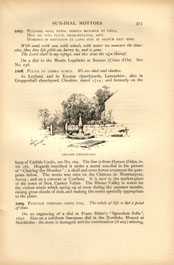
[Full Image]
LEYLAND CHURCHYARD.
| 1007. | PULVERE, SOLE, ROTIS, TEMPUS METIMUR ET UNDA, With sand, with sun, with wheels, with water we measure the time: alas, thus does life glide on, hurry by, and is gone. The Lord shall be my refuge, and this stone the sign thereof. On a dial in the Musée Lapidaire at Beaune (Côtes d'Or). See No. 236. |
| 1008. | PULVIS ET UMBRA SUMUS. We are dust and shadow. In Leyland, and in Euxton churchyards, Lancashire; also in Grappenhall churchyard, Cheshire, dated 1714; and formerly on the keep of Carlisle Castle, see No. 169. The line is from Horace (Odes, iv. vii. 16). Hogarth inscribed it under a mural sun-dial in his picture of "Chairing the Member"; a skull and cross-bones ornament the gateposts below. The motto was once on the Château de Montmayeur, Savoy; and on a convent at Conflans. It is now in the market-place of the town of Sion, Canton Valais. The Rhone Valley is noted for the violent winds which spring up at noon during the summer months, raising great clouds of dust, and making the the motto specially appropriate to the place. |
| 1009. | PUNCTUM TEMPORIS OMNIS VITA. The whole of life is but a point of time. On an engraving of a dial in Franz Ritter's "Speculum Solis", 1652. Also on a cubiform limestone dial in the Nordiska Museet at Stockholm : the stone is damaged, and the continuation (if any) missing. |
| 1010. | PUÒ FALLARE LA CAMPANA IL FERRO, At Comano, in the Trentino. |
| 1011. |
QUA HORA NON PUTATIS FILIUS HOMINIS VENIET. On a portable universal dial of brass in the Museum at Trèves. The text has also been read at Mayenne. QUA NON PUTATIS. In the hour ye think not. Was formerly in the Rue du Faubourg St. Martin, Paris. |
| 1012. | QUA REDIT NESCITIS HORAM. Ye know not the hour in which He returns. The western dial thus inscribed stood formerly on an old gable in Lincoln's Inn. It was renewed in 1794, when the great William Pitt was treasurer, and bears this date and the initials W. P. When the old buildings were taken down, the dial was removed to the Stone Buildings, and placed near the windows of Mr. Pitt's chambers. The same motto is at the Chantry, Newark (see No. 1176): and on Threckingham Church, Lincolnshire. On a stone pillar at Scartho, near Grimsby, is a brass dial engraved QUA REDIT HORAM NESCITIS. |
| 1013. | QUAE EST ENIM VITA VESTRA? VAPOR ENIM EST AD EXIGUUM TEMPUS APPARENS. For what is your life? It is even a vapour that appeareth for a little time. – St. James, iv. 14. Ambrose Crowley, anno 1713. On the outer gable of an old building in Grace's paper works, Swalwell, co. Durham. These with the steel works of Ridley and Co. formed the famous works of Ambrose Crowley at the end of the seventeenth and beginning of the eighteenth centuries. "He was, I believe," writes Mr. R. Blair, "the first iron worker on Tyneside, or rather on Derwentside, the Derwent being a tributary of the Tyne. His workmen were a very boisterous set, and to this day parents speak of their children when very rough and noisy, as being like 'Crowley's crew.'" |
| 1014. |
QUÆ LENTA ACCEDIT QUAM VELOX PRÆTERIT HORA. Simpson A.D. 1820. On a dial at Wigton Hall, Cumberland. A writer in "Notes and |
Queries" (5th Ser. v. 235) says "The following Latin motto is by Cowper; the translation said to be by Hayley.
Quae lenta accedit, quam velox praeterit hora! |
|
| 1015. | QUAE TUA SIT NESCIS, HORAM DUM FUGIT OCCUPA. Thine hour thou knowest not, seize the hour while it flies. At Rayon (Basses Alpes). |
| 1016. | QUAELIBET EST INDEX FUNERIS HORA TUI. Any hour is the signal for thy death. On an ivory portarium in the National Museum at Munich, with No. 606. Also on a dial in Mr. Evan's collection. See No. 37. |
| 1017. | QUAERE BONUM. Seek that which is good. At Oyeu (Isère). |
| 1018. | QUAEVIS HORA FORTASSE POSTREMA. Any hour is perchance the last. On the Franciscan convent of Mesma, Italy. |
| 1019. | QUAEVIS HORA MORTIS INDICINA. On a brass and silver nocturnal dial in Mr. Evans' collection. It is of south German make, and the face is decorated with the engraving of a full moon. The last three lines of the motto are below the moon, and in context with the lunar tables. |
| 1020. | QUALIS UMBRA DIES NOSTRI. Our days are as a shadow. On a château belonging to Baron Perrier de la Batie, Savoy. |
| 1021. | QUALIS VITA FINIS ITA. As the life, so the end. At Ballafreer Farm, Isle of Man, with Nos. 57, 90. Formerly on the church at Great Smeaton, Yorkshire, with "W. Deacon, 1809", but the dial was removed in 1872. See No. 647. |
| 1022. | QUAM CITO JUCUNDI PRAETERIERE DIES. How quickly the pleasant days have passed away. On a cruciform dial erected by the Rev. W. L. Bowles in the |
Grounds of his canonical residence in the Close, Salisbury, 1829. It is no longer there. |
|
| 1023. | QUAND JE NE VOIS PAS CLAIR, JE ME TAIS. When I cannot see, I am silent. At Boileau. |
| 1024. | QUANDO APPARES EGO PROPERO. When thou appearest I hasten on. On the church of St. Paulen (Haute Loire). |
| 1025. | QUANDO DI NUBI AL SOL SGOMBRA È LA VIA, Beyond Varenna the road to Colico winds along the shores of the Lake of Como, and passes a little roadside osteria, over the door of which is a rough sun-dial with the above motto. It serves as a sign to the inn, as well as to indicate the time. |
| 1026. | QUAS PERDITIS HORAS QUAERITIS. Ye seek the hours ye waste. Formerly in the court of the Convent des Théatins, Paris. |
| 1027. | QUAS UMBRA SIGNET VIRTUS. Let virtue mark the hour the shadow tells. On the Hôtel de Ville, Beaufort, Savoy, with No. 1186. |
| 1028. | QUASI PHOENIX EX CINERE MEO RESURGAM. Like the Phœnix I shall arise from mine ashes. At Chatillon, Val d'Aosta, with No. 43. |
| 1029. |
On a house opposite the gate of the Abbey of Maymac (Corrèze). ("L'Intermédiaire," vol. xv.) |
| 1030. | QUE LA VERTU SOIT DE TOUTE HEURE. May virtue be ever present. At Beaufort, Savoy. |
||||||
| 1031. | QUE T'IMPORTE QUELLE HEURE IL EST OU QU'IL N'EST PAS? Formerly over the door of a cabaret at Barde, near Montmorency. |
||||||
| 1032. |
QUE TOUTES LES HEURES DU JOUR VOUS TROUVENT Let every hour of the day find you working for eternity. At Abriès (Hautes Alpes). |
||||||
| 1033. |
QUELLE HEURE EST- IL? At Les Orres (Hautes Alpes). "Andeyer" was name of a former Maire. |
||||||
| 1034. | QUI BENE VIVIT, BENE MORITUR. Who liveth well, dieth well. At the Maison-du-Roi, Queyras (Hautes Alpes), with No. 552. |
||||||
| 1035. |
On a large dial painted on the wall above the south door of |
St. Lorenz Kirche at Nuremberg. The translation of this inscription has been kindly undertaken by Mr. Evans, and his extensive knowledge of practical dialling and ancient instruments has thrown light on allusions which completely baffled those who were classical scholars only. "Fair Reader, who dost desire to know the series of the hours of the day (i. e. the number of hours in the day, or length of daylight), look on this accurate work: or, if thou shouldest wish to learn a certain hour in the middle of the daylight, a red line teaches thee the hour with certainty (liquido). Or if you seek to take down the hours from sunrise you see that they are distinguished by dark lines, although the hours of each day are equal, still they face the others (that is the ordinary hours marked with the red lines) with unlike space; if you do not understand the difference, the hyperbola explains it, which the renowned (or easily understood) conics of Apollonius will give you. "Apollonius of Perga, B.C. 240, wrote a great work on conic sections. This description is interesting when read in connection with cap. xxxvii. of Munster's 'Horologiographia' (published 1531), where he advocates the use of coloured lines to make more clear the various hours marked on the dials, and quotes two Latin poems bearing on the subject" (L. E.) Below the description is the name of the dial-maker, Sebastian Sperantius, and the date 1503; after this the motto Learn to live – think upon death. Then come two imperfect lines in which the name of Johannes Stabius appears, who is referred to by Munster as one of the chief writers on gnomonics in the sixteenth century; also the name Maximilian, and three dates recording the renovations of the dial. |
|
| 1036. | QUI FAIT DU BIEN ET LE PUBLIE Le Replat, Aime (Savoy). |
| 1037. | QUI (CUI) HORA NON PUTRIS. For whom is the hour not fleeting? On a dial made by Frère Arsène, capuchin, at Annecy (Haute Savoie). |
| 1038. | QUI LABORAT ORAT. 1784. Who works prays. At St. Romans (Isère). "O not unowned, Thou shalt unnamed forgive, |
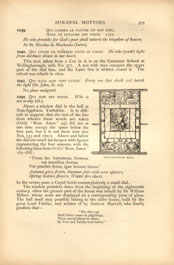
[Full Image]
NUN-APPLETON HALL.
| 1039. | QUI LOGERA LE PAUVRE DU BON DIEU, He who provides for God's poor shall inherit the kingdom of heaven. At St. Nicolas de Macherin (Isère). |
| 1040. | QUI LUCEM DE TENEBRIS LUCET IN CORDE. He who (sends) light from darkness shines in our heart. This text, taken from 2 Cor. iv. 6, is on the Grammar School at Wellingborough, with No. 377. A sun with rays occupies the upper part of the dial face, and the Latin line is written round it. The school was rebuilt in 1620. |
| 1041. | QUI MALE AGIT ODIT LUCEM. Every one that doeth evil hateth the light (St. John, iii. 20). No place assigned. |
| 1042. | QUI NON EST HODIE. Who is not to-day (lit.). Above a window dial in the hall at Nun-Appleton, Yorkshire. It is difficult to suppose that the rest of the line from whence these words are taken (Ovid, "Rem. Amor." 94) did not at one time occupy the space below the first part, but it is not there now (see Nos. 533 and 1601). Above and below the dial are small landscapes with figures representing the four seasons, with the following lines from Ovid ("Rem. Amor." 187-188): "Poma dat Autumnus, formosa est messibus Aestas, In the centre pane a Cupid holds contemplatively a small dial. The window probably dates from the beginning of the eighteenth century, when the greater part of the house was rebuilt by Sir William Milner, whose arms are displayed on a corresponding pane of glass. The hall itself may possibly belong to the older house, built by the great Lord Fairfax, and written of by Andrew Marvell, who fondly predicts that – "The after age |
| 1043. | QVI QVASI FLOS EGREDITVR ET CONTERITVR ET FVGIT VELVTI VMBRA. He cometh forth as a flower, and is cut down, he fleeth also as a shadow (Job, xiv. 2). On a brass hexagonal dial-plate in the Victoria and Albert Museum. The chronogram appears to be 1746. |
| 1044. | QUI RODIT RODITUR. The consumer is consumed. At St. Romans (Isère). |
| 1045. | QUI SCIT AN EXTREMAM STILUS MIHI DENOTET HORAM? Who knows if the style is marking my last hour? Formerly in the cloister of the Convent des Petits Augustins, Paris, now the Ecole des Beaux Arts. |
| 1046. | QUICONQUE AIME SON DIEU LA LOI ET LA PATRIE At Maison Boyer, Cormeil (Var). This version probably dates from the Revolution period. |
| 1047. | QUICONQUE AIME SON DIEU, SON ROI, ET SA PATRIE Formerly on Maison Bertrand, Aups (Var), but was effaced in 1792, and another motto, AMICIS QUÆLIBET HORA, painted over it. The remains of the first one can still be seen below the other. |
| 1048. | QUID CELERIUS TEMPUS? What is swifter (than) time? One of the mottoes on the cross dial at Elleslie, near Chichester (see No. 104). QUID CELERIUS TEMPORE is on Mr. A. Egginton's dial at South Ella (see No. 932). |
| 1049. | QUID CELERIUS UMBRA? What swifter than shadow? On a dial which formerly stood in the Isle of Man, and is now at Barnes Lodge, King's Langley (see Nos. 161 and 788). |
| 1050. | QUID LUCIDIUS SOLE? ET HIC DEFICIET. What is brighter than the sun? Yet the light thereof will fail (Ecclus. xvii. 30). Given in "Notizie Gnomoniche." |
| 1051. | QUID SINE SOLE? NIHIL. 1694. What without the sun? Nothing. At Briollay (Maine et Loire). |
